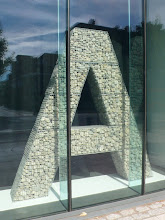232 Kingsland Road
‘Fantastic’ felafel and a bottle of water
The shopfront states that Ali’s was the first kebab house to open in East London in 1969. I don’t know if this is true, but it seems an appropriate place to finish my own journey at somewhere that was the start of another. The posters in the window proclaim his felafel to be the best in the world, and the menu lists it as ‘Fantastic’ felafel, so I order a portion. I take a seat in the window and Ali, for I presume it is him, begins to prepare my food. A group of three men sit eating at the table nearest the counter and chat with him as he works. They seem to be friends or at least regulars. It is a long thin space that is dominated by a huge mural that runs along the wall directly in front of me. It seems to be a scene from a Cuban bar.

The radio is tuned to Smooth and is playing a range of mellow tracks. Kingsland Road seems strangely quiet apart from the buses that pull up at the stop outside at regular intervals. I suppose at this point in the road we are not quite Shoreditch and not quite Dalston, maybe that’s why.

My felafel arrives and I tuck in. It is unlike most felafel I have eaten before—it is served in a flat, pattie type shape and isn’t crispy on the outside. It has a slice of melted cheese on top and seems to be auditioning for the role of felafel burger. It’s nice though.

Another customer comes in and orders the felafel. Ali calls over to me ‘all right love?’ ‘Mmm, great’, I reply, with a thumbs up. ‘See, my felafel is different from others’ he says. ‘Mmm, fantastic felafel’, I say. I go up to the counter to pay and notice all sorts of things that I missed when ordering; a big assortment of photos of Ali through the ages; an old fashioned mincer with worms of mince piled in the tray and suspended in action at the mouth of the contraption; a set of optics next to the drinks fridge; and, I also see he is open until 2am on weekdays and 5am at weekends. We chat about the photos and he is proud of his children, grandchildren and now great grandchildren. I’d like to take some photos of all of the stuff, but it seems too intrusive, for it doesn’t feel like a business, it feels like part of his life.
AFTERS
The end of the journey
Over the course of eight weeks last summer I ate and drank my way from one end of Hackney to the other, and in doing so, took a culinary journey from one side of the world to the other. I chewed the fat with Brazilian football fans and chewed chat with Ethiopians; I shopped before Shabbat and ate breakfast at the start of Ramadan; and, I learnt more than I could have imagined about Hackney, kosher food, legal highs, and countless other things. I have found food not only to be central to social identity and to creating bonds with friends and family, but I have also found it central to the complex network of local and global connections that make place. The consumption of a fifty pence Polish chocolate bar produced by a brand that, in turn, has been bought and sold by British, American and Asian companies, instantly highlights the far reaching nature of such a seemingly inconsequential item.
Yet somehow, even in some of the more exotic, seemingly more ‘global’ establishments, I had what I can only describe as a local experience. Places like Andu Internet Café or Shanghai could never be compared to the global ‘non-places’ of Starbucks or McDonald’s. The service, the decor, and in Andu’s case, the lack of menu, don’t conform to any type of corporate masterplan. Idiosyncratic places such as these seem entirely in keeping with Hackney. It is a borough that is not only home to a hugely diverse population, but is also one that seemingly desires to repel major corporate incursions; to retain a streetscape that supports local independent traders as opposed to building a brand ridden ‘blandscape’ populated by outlets such as Costa Coffee, Pret A Manger, and Pizza Hut.
Some of the food I have eaten has been fantastic, with highlights being Turkish breakfast at Şömine, lunch at Andu, breakfast at Mr Bagel, and the double with chana from the Roti Stop. Drinks have provided my worst moments with Şalgam and coconut juice sharing the honours for the most undrinkable. However, ultimately the whole experience has been about much more than just food and drink. The process of engaging with place in this way has led to a huge range of experiences and reflections about customs, cultures and beliefs, with my own often being brought sharply into focus—often through difference. By taking such a central role in the process, one cannot fail to reflect on that position itself. Often this manifested itself in questions of belonging that ran through the full spectrum of issues surrounding gender, class, ethnicity and sexuality. So, whilst I learnt more about Hackney, I also learnt much about myself. However, differences aside, rarely did I receive anything but a warm welcome and genuine pleasure that I had enjoyed what I had ordered.
These posts are just a small section of the contents of the book—Food Miles—that was the end result of my journey. The next post will, finally, get round to talking about the design of the book itself.



No comments:
Post a Comment